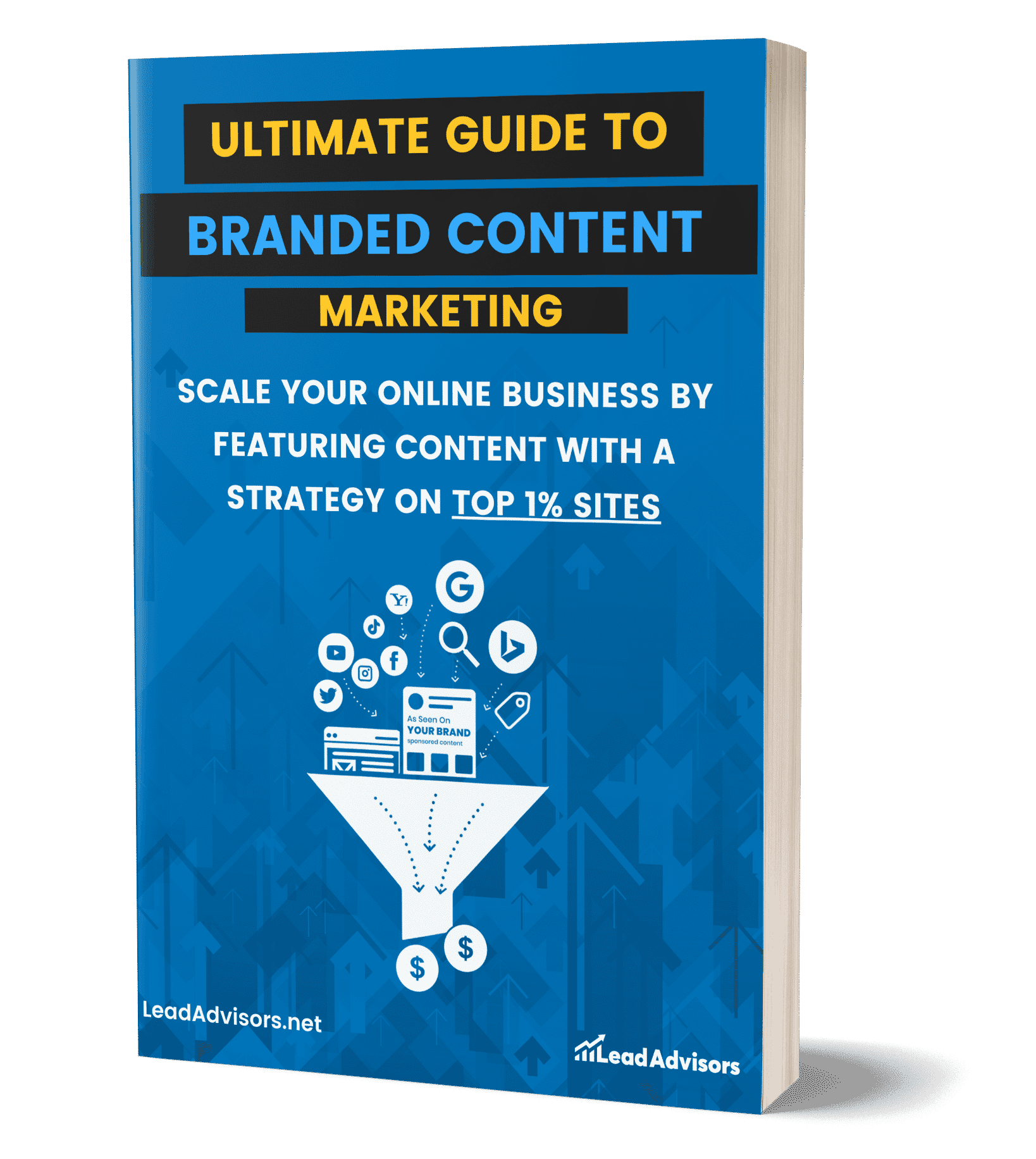Have you ever wondered why the ad campaigns you launch with killer design and life-changing copy fall flat? It’s most likely that you’re not running behavioral targeting.
Rather than making assumptions about who you should target, behavioral targeting leverages real (as in: verifiable) behavioral data like clicks, visits, and time on page to show people what they actually want to see. That’s how behavioral targeting operates: It reads the signals and responds appropriately.
Behavioral targeting, unlike old-school contextual targeting based upon where the ad is served, targets the person by their actions. It’s crisper, bolder, and just flat-out better.
Quick fact: Personalized ads with behavioral targeting boost engagement by 33 to 48%. That’s huge.
The behavioral targeting process is no magic trick – it’s just clever marketing. Track behavior, learn patterns, and deliver value. That’s how leading brands convert browsers into buyers with smarter marketing campaigns.
If you’re still doing behavioral advertising without personalization, you leave money on the table.
Let’s fix that.
How Behavioral Targeting Works
Let’s break it down step by step. Imagine you run a lemonade stand, and you want to offer each customer their favorite drink at the perfect time. Behavioral targeting helps you do that, but with display ads, websites, and marketing messages.

Step 1: Data Collection – Watching & Listening
First, you watch what people do – not in any spy-like way, but attentively.
Think of it like this:
- Somebody comes to your website and checks out strawberry lemonade.
- They scroll for a bit, maybe click “Add to Cart,” and then leave.
- Someone else opens up your mobile app on their phone and purchases regular lemonade every single Sunday.
- A third person clicks on a link in your email but doesn’t linger.
You collect all these actions using tools like cookies (tiny trackers), pixels (invisible dots on a webpage), or tools like Google Analytics or your CRM system. This is called data collection.
Step 2: Behavioral Segmentation – Sorting the People
So, now that you’ve gathered all this behavior data, let’s organize it – say, as you might sort Lego pieces into piles by color or shape.
This is called behavioral segmentation.
For example:
- People who clicked on the strawberry but didn’t buy
- People who bought lemonade three times in a row
- People who always shop late at night
But here is where it gets clever. You don’t end with behavior. You combine this with other data, such as age, location, or a personality characteristic. This is where demographic and psychographic information is helpful.
Suddenly, your target audience is no longer “people 25–40.” It’s “people 25 to 40 who love fruit flavors, shop at night, and use iPhones.” Now, you can target customers based on what counts.
Step 3: Personalized Content Delivery – Saying the Right Thing at the Right Time
Now that you know who your people are and what they like, it’s time to talk to them like a real person.
This step is where your behavioral targeting efforts come into play.
Imagine if someone just kept staring at strawberry lemonade but never purchased it. You could even email them something like, “Indulge in a strawberry still? Here’s 10% off!” Or serve up a more relevant ad during their social media scroll. That’s personalized content.
You can deliver:
- Relevant content on your website (“Welcome back! We saved your favorites.”)
- A push notification on your mobile app
- A Facebook ad that says, “Strawberry fans get this special today only.”
- Or an email saying, “We noticed you love lemonade – here’s a new flavor!”
That’s really personalized content delivery, and that’s how behavioral marketing can help you convert browsing customers into buyers.
Benefits of Behavioral Targeting
Imagine going to a website and finding precisely what you were looking for as soon as you arrive, before you even have a chance to type what you were searching for into a search box. Hence, the power of onsite behavioral targeting. It pays attention to your clicks, scrolls, and intentions. No guesswork. Just smart, understated personalization.
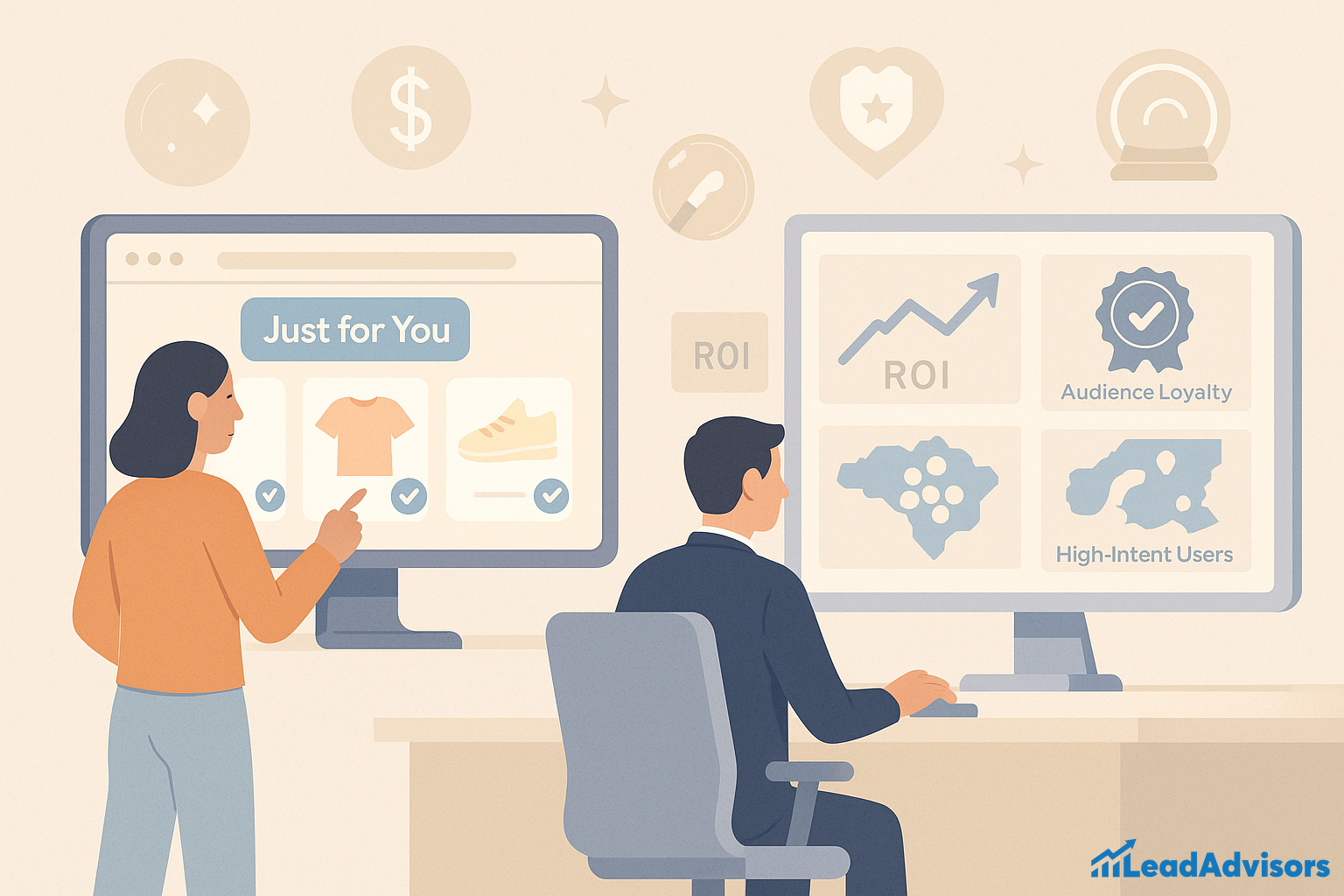
Now flip it – you’re the brand. “But when you get to behavioral targeting, you’re treating every single person who comes to your site moments before they even arrive to your home in a way that is a message for them, because it’s behavior-based, it’s not demographic-based, it’s not psychographic-based but it’s action-based at the time of how the consumer is behaving.”
That’s where the magic begins.
You Get More Relevant Results
When you stop sending the same signal to everyone and start crafting creative based on what users are searching for, clicking on, or purchasing before, you’re not just creating a Google ad – you’re making more relevant ads. That’s when visitors start clicking through, staying, and converting – especially when supported by a well-structured Google Ads campaign.
You Save Money (And Get Better ROI)
Consider this: Rather than wasting ad spend on cold leads, your behavioral targeting campaigns hone in on high-intent users. You connect with people only when they are already in the right buying mood, which minimizes wasted impressions and improves the return on your investment.
You Build Real Loyalty
When your marketing messages seem personal, like you’re talking to someone who’s been here before and whose preferences matter, people are more likely to linger. Behavioral targeting allows you to develop ongoing, trust-building, and relationship-building content.
You Reach New, High-Intent Audiences
As you get more precise with who you’re targeting, your audience grows smarter, too. You start being exposed to the kind of users with high potential by leveraging and spotting trends in behavioral data. These are not only new leads, they’re better leads.
You Future-Proof Your Strategy
And here’s the real whopper: this is not just a story about conversions today. It’s about tomorrow. The more you know about behavioral segmentation, the more predictive you get. You’re starting to see patterns before they recycle, so you’re a step ahead of the game.
Behavioural targeting vs. contextual targeting? There’s room for both. But when it comes to really knowing your customers, not just the page that they are on, behavioral marketing will put you ahead.
Types of Behavioral Targeting (And How They Show Up in the Real World)
The good news is that now that you understand the power of behavioral targeting, the next step is to know your tools. Because it is not a one-size-fits-all strategy. You’ll have various types of Behavioral Targeting, all built to serve different moments in your customer’s journey.
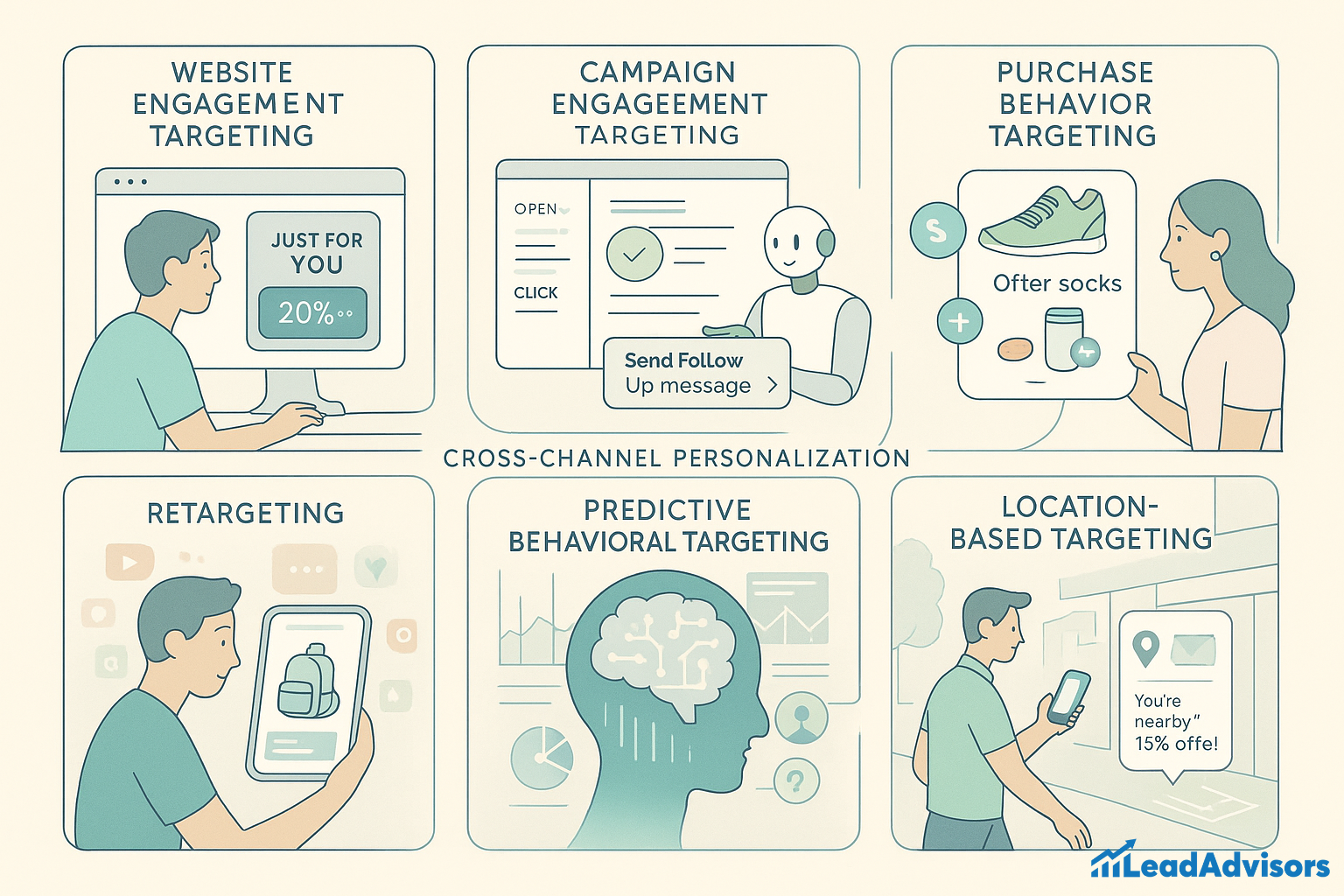
Let’s walk through them.
Website Engagement Targeting
So imagine this: A return visitor arrives on your homepage. This time, when they return, they’re welcomed with a personalized banner giving them a discount off the very same product they looked at last week. That, my friends, is onsite behavioral targeting in action. Whether it’s a smart pop-up, a modified landing page, or a webpage that says hello, you are leveraging engagement data to adapt the website experience on the fly.
This trumps the genericness of contextual targeting ads, which are limited to the page’s content and do not use the actual user’s behavior. They respond to the room rather than the person.
Campaign Engagement Targeting
Have you ever opened an email about something you love, clicked through to the link to that site, and then a day later, received a follow-up email encouraging you to complete the action you started? That’s what campaign engagement targeting is. And whether people open, click, or don’t open at all, you can write ultra-specific follow-up emails that help users where they are, emotionally and behaviorally.
Smart marketers realize that behavioural segmentation is more than what happens on their sites – it’s also what happens with their campaigns.
Purchase Behavior Targeting
Say someone just bought a pair of sneakers. A week later, they received an email offering them socks or perhaps a waterproof spray. This is traditional purchase behavior targeting. You’re simply leveraging that customer data to offer upsells, complementary product suggestions, or reminders when they abandon a cart.
You’re not merely collecting information – you’re constructing bright points in time, encouraging people to march forward on real customer behavior.
Retargeting
This one’s powerful. Have you ever been scrolling through social media and seeing something you wanted to buy, and then, out of nowhere, that thing is everywhere? That’s retargeting – you are promoting brand recall across channels, leveraging someone’s previous interest.”
You remember that old “Rule of Seven” in marketing, right? It tells us that people need to receive seven messages before they finally act. With multichannel retargeting, you can make those seven exposures occur more rapidly and organically, without annoying them.
Predictive Behavioral Targeting
Now we’re getting futuristic. Predictive targeting uses AI and machine learning to predict what a user might do next, such as who is likely to buy again or who might churn. It’s proactive marketing driven by consumer data and trends in behavior, letting you move before the customer even knows.
Location-Based Targeting
You pass a coffee shop, and boom – your phone buzzes with a 15% off promotion. That’s how location-based targeting works. With geo-fencing and proximity tools, marketers can deliver messages and offers based on where someone is at that moment. It gives physical behavior an interface to the digital world.
In today’s world of mobilization, this type of targeting works wonders; it makes your digital ads feel timely and hyper-relevant.
Cross-Channel Personalization
Finally, cross-channel personalization is the glue that binds it all together. Say someone views your site on their laptop, clicks a retargeted ad on Instagram, and then receives a follow-up SMS – a pattern you can reinforce using strong Facebook marketing strategies.
With the right tech, the experience remains seamless, consistent, and touchingly personal. The messaging changes, but its foundation, based on gathering data and knowing behavior points, is sharpened on every channel.
Behavioral Targeting vs. Contextual Targeting
| Aspect | Behavioral Targeting | Contextual Targeting |
| Focus | User-focused – based on past actions, preferences, clicks | Content-focused – based on webpage or app content |
| Data Source | Behavioral data (e.g., browsing history, purchases, time on site) | Keywords, categories, and context of the page being viewed |
| Personalization | High – delivers more relevant ads based on individual behavior | Moderate – relevance is tied to the content, not the individual |
| Privacy Considerations | More sensitive – relies on consumer data and tracking | Less invasive – does not track user behavior |
| Strengths | Predictive, tailored, effective for retargeting & personalization | Cookieless, privacy-friendly, immediate content relevance |
| Weaknesses | May require consent; dependent on cookies and tracking tools | Lacks deep personalization; may miss behavioral context |
| Best Use Cases | Retargeting, email personalization, and dynamic ads | Brand safety, contextual placements, interest-based content |
| Winning Strategy | Combine both: use behavioral for personalized targeting, contextual for privacy-safe expansion. You can also strengthen results by combining behavioral targeting with native advertising, which blends promotional content naturally into user experiences. |
Best Practices for Effective Behavioral Targeting
So, you’ve begun dabbling with behavioral targeting, and you’re seeing some good results. But great power also has the power to either thrill or totally freak people out.
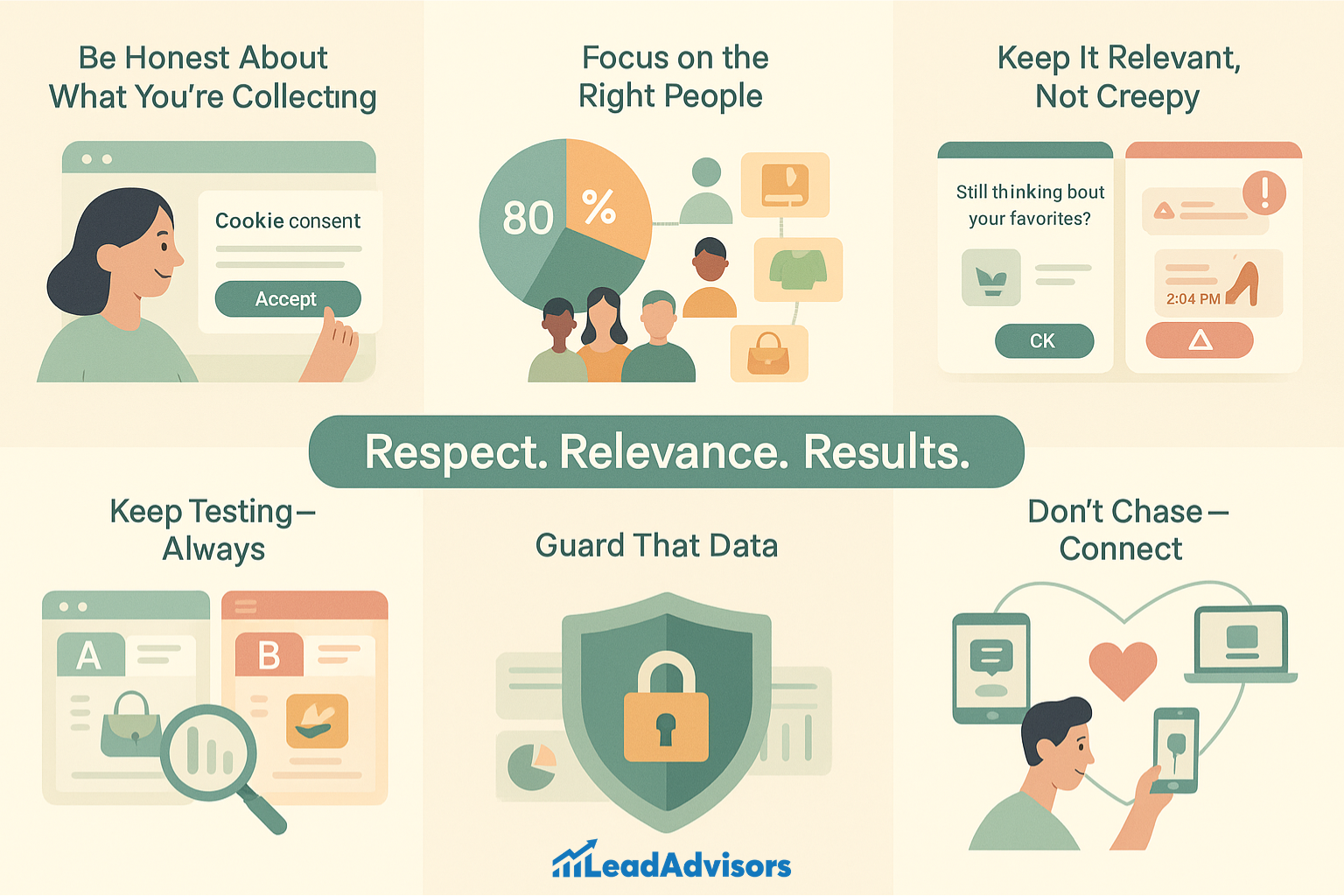
Here’s how to stay on the delight end of the spectrum and maximize your targeting without being creepy or wasteful.
Be Honest About What You’re Collecting
We’ll start with the low-hanging fruit: if you’re collecting data from your users (like their click streams, user preferences, purchase history), tell them. People are so much more willing to give you information when they know what you’re doing with it. Make cookie notices upfront, request explicit opt-ins, and adhere to privacy regulations such as GDPR.
Trust is the game’s name, and being shady with consumer data is the quickest way to lose it.”
Focus on the Right People, Not All the People
You don’t have to reach everybody. Really, you shouldn’t. Apply the good old 80/20 principle: in general, 20% of your audience will contribute to 80% of your revenue. Concentrate your energy on those high-value people.
Monitor their visits as users, what content they return to, and what they nearly purchase, and create your strategy around that. These are your people. Treat them like VIPs.
Keep It Relevant, Not Creepy
Personalization is great … until it’s not. You know when the ad is simply a bit too on-the-nose? Like it’s been eavesdropping? Yeah, don’t do that.
Behavioral targeting should be helpful, not creepy. Seriously, why don’t we also say, “Hey, Sarah, are you still considering those red heels you looked at at 2:04 PM Tuesday?” or something softer like, “Still contemplating your top picks? They’re almost gone!”
Pro tip: If you can, pair it with some contextual advertising. This way, your ads are relevant to the content someone is looking at and also aligned with what they’ve done in the past – a win-win.
Keep Testing – Always
And here’s a truth bomb: what was good last month could totally flop next week. That’s why A/B testing is your new BFF. Try different headlines, images, offers, and even formats like video – this guide to video advertising is a great place to start. Perhaps people are more responsive to an offer after dinner, or on Sundays. You won’t know unless you try it.
The more you tweak, the more you learn, and the better the campaign results.
Guard That Data Like It’s Your Bank Account
You collect consumer data; you’d better secure it. No one wants their stuff to get leaked, and if it happens on your watch, they trust it simply won’t happen again.
Use secure platforms, keep things encrypted, and stay compliant. Privacy isn’t a checkbox – it’s a promise.
Don’t Chase – Connect
The point is not to pester people around the web until they surrender. It is to reach and resonate with eventual customers regularly with content that really matters to them. If you deploy targeted advertising based on the real actions and interests of committed economic performers who are open to your ads, then you’re not bugging them; you’re helping them.
It’s not just cleverness that behavioral targeting is about. It’s about being human. When you strike that balance, your audience will feel seen, not stalked. And here’s where the magic happens.
How Behavioral Targeting Comes to Life Across Industries
If you’ve ever questioned whether behavioral targeting is meaningful beyond ad tech or retail, you’re not alone. In fact, it’s all around us. The targeting method behind it is quietly driving smarter experiences in lots of other industries.
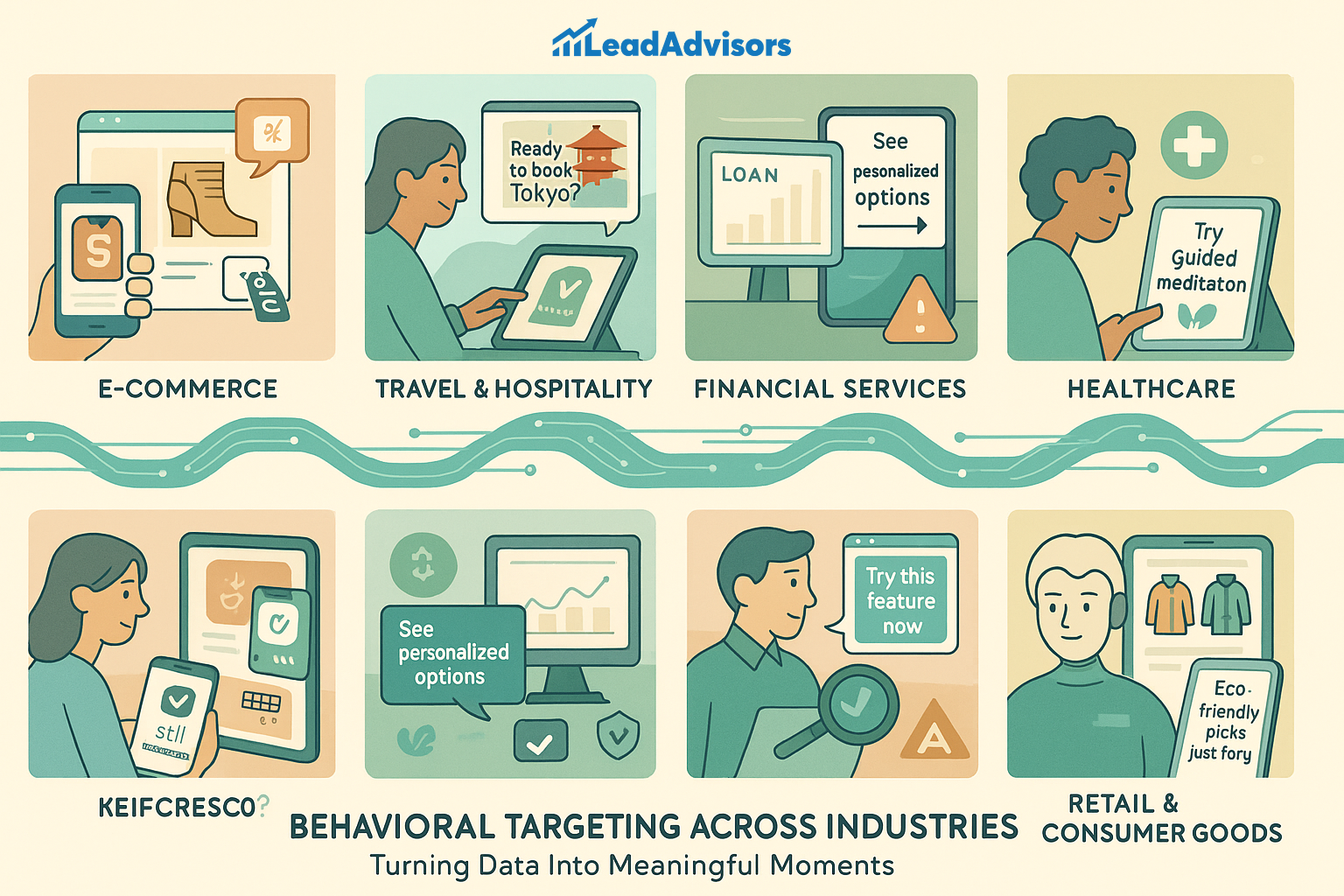
Let’s take a little tour, shall we?
E-commerce
We’ve all been there: you shop for a product, you leave without purchasing, and the next day – bam – it’s back in your inbox or as an Instagram ad. That’s not luck. That’s behavioral targeting for you.
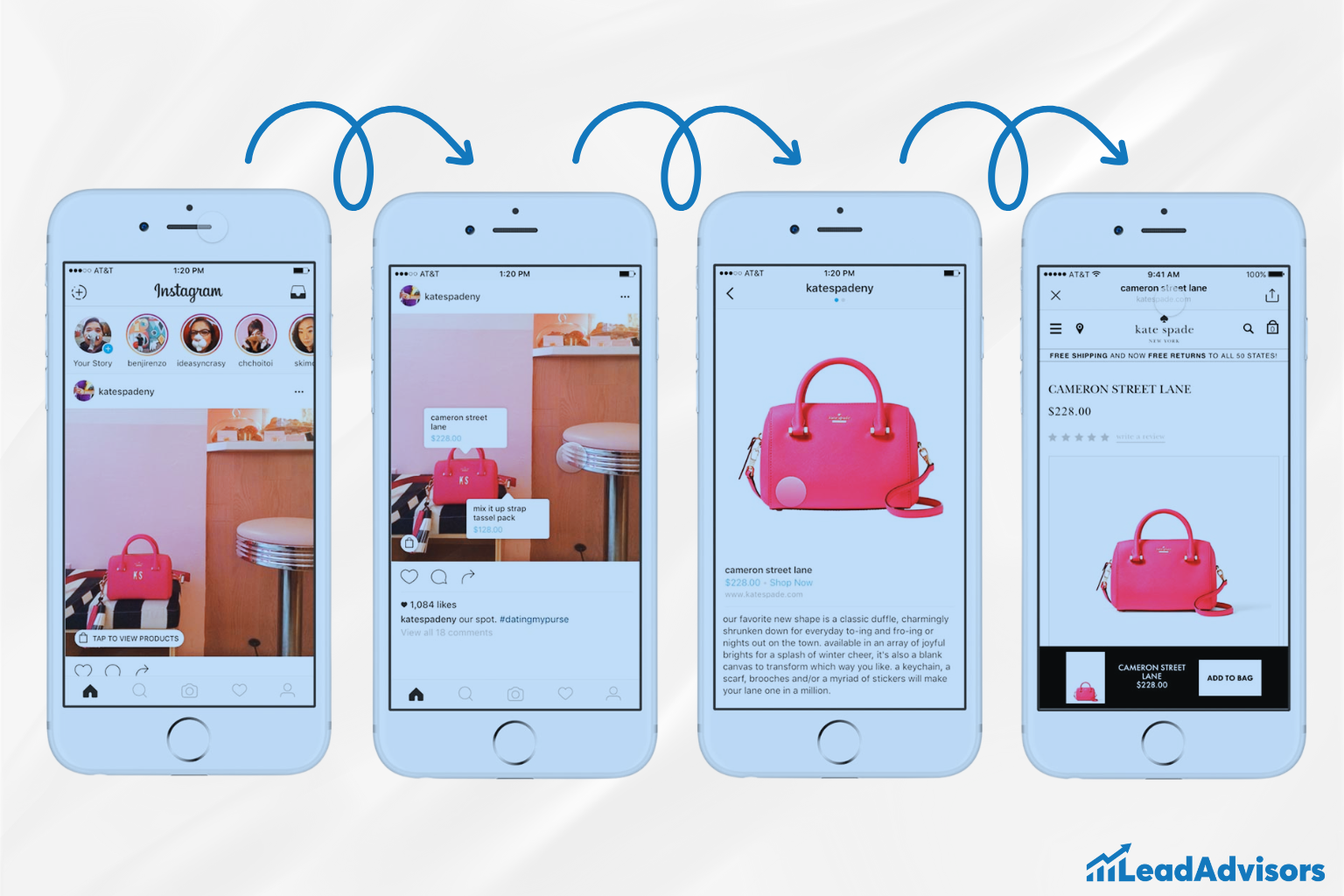
E-commerce brands, from their abandoned cart recovery programs to suggesting products based on browsing history or purchase intent, also depend significantly on segmenting users based on their behavior to surface the right content that coaxes people back to purchase. And yes, it works – conversion rates go through the roof when someone feels the product is speaking directly to him or her.
Travel & Hospitality
Behavioral targeting is pretty much tailor-made for this environment. For instance, if someone looks up flights to Tokyo three times in a single week, instead of simply receiving a generic travel ad, they now receive more personalized ads for deals on hotels, travel insurance, or a curated experience of Tokyo.
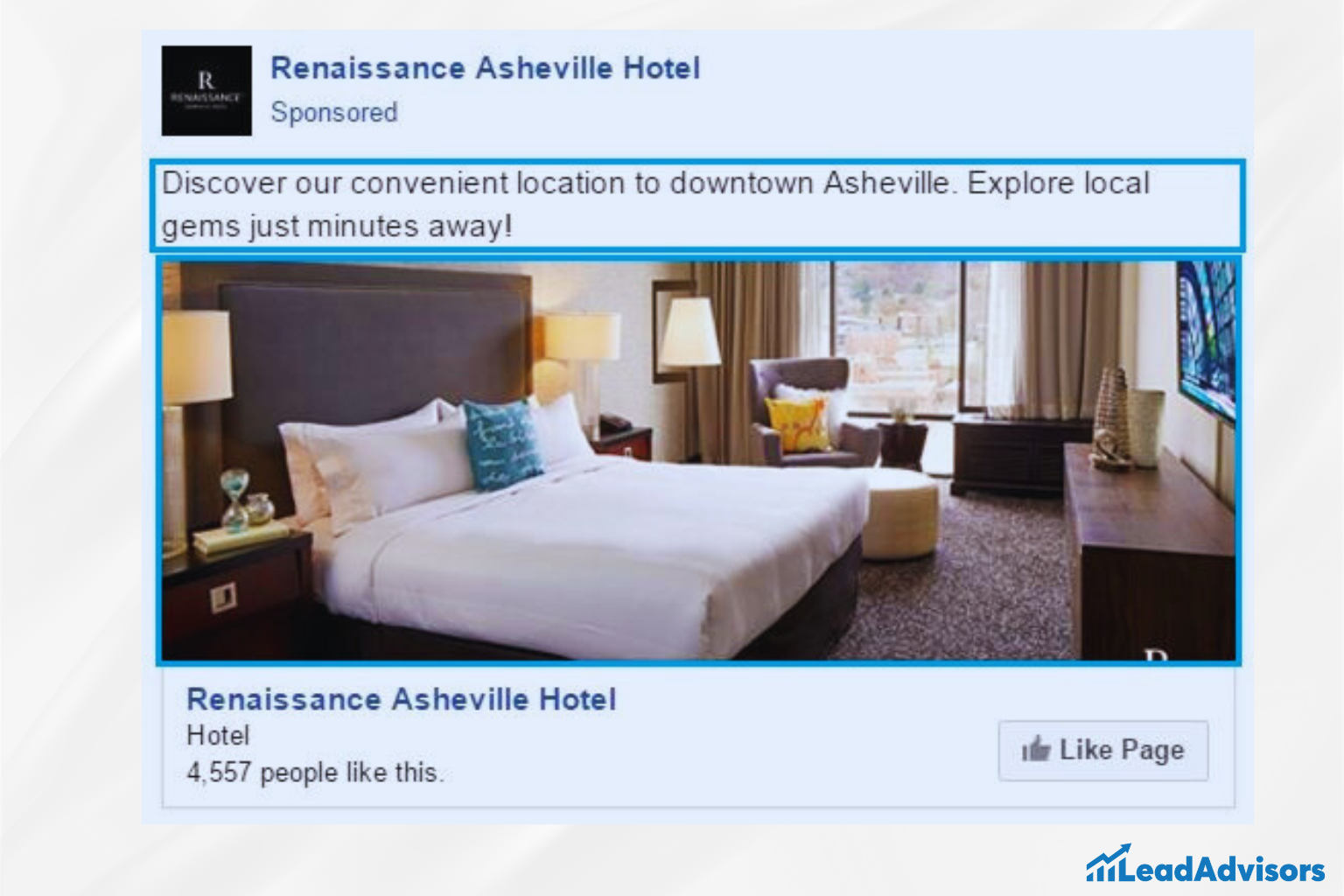
Even better? A gentle reminder email: “Ready to book your next adventure? It is not just marketing – it is helpful. The timing is perfect, since it has to be.
Financial Services
Now this one’s tricky. You do not want to be harmful, let alone intrusive. Smart financial brands leverage targeted advertising for actions such as showing interest in loan calculators, savings tools, or credit card comparisons.

Rather than screaming “Apply Now” to everybody, they offer personalized products only to individuals with high intent. Some even employ behavioral triggers to help identify suspicious usage for better fraud detection before the user has a chance to notice that something is amiss.
Healthcare
For health care, it’s all about getting relevant content in front of people – but with some empathy. For instance, say someone learns about stress or sleep problems on a wellness site. Placed just right, a nudge like “Explore guided meditation plans” or “Take our sleep self-assessment” demonstrates that behavior targeting can not only serve as an education and support tool but also as a sales solution.
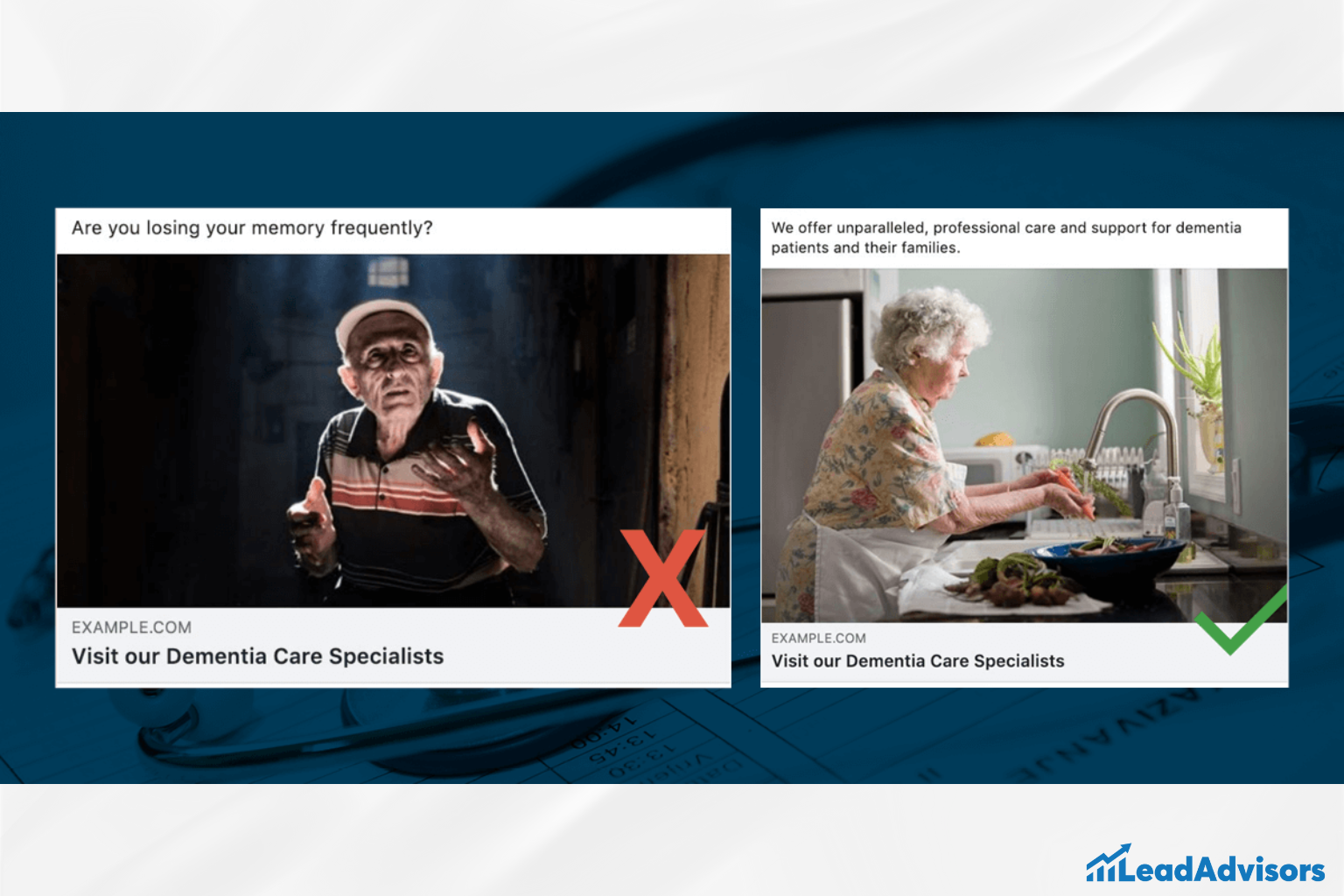
It is also a potent tool for promoting preventive care or reminding users about appointments and health programs based on their past interactions.
Technology & SaaS
This is a business that eats, sleeps, and breathes behavior. From tailored onboarding campaigns to gently prodding dormant users to engage with new functionality, software-as-a-service companies are constantly analysing how people use their products.
Behavioral targeting enables reaching target users, upselling highly engaged users, and sending the perfect nudge at the ideal moment to drive more engagement.
Retail & Consumer Goods
That’s where seasonality meets savvy scheduling. A shopper who purchases boots in October might be shown winter coats in November. The next time someone who shops for eco-friendly products logs into the site, they might see a specially curated list for them.
Brands personalize segments based on customer behavior, preference, and timing information to encourage loyalty, and they leverage behavioral targeting to retain tailored experiences without bombarding shoppers.
Behavioral targeting is essential regardless of industry because it changes mass marketing blasts to laser-focused relevancy. Instead of making assumptions about what people might want, you’re responding to what they’ve actually told you, in terms of taps made, time spent, user searches conducted, and habits.
Key Metrics to Measure Behavioral Targeting Success
| Metric | What It Measures | Why It Matters for Behavioral Targeting |
| Engagement Rates | Opens, clicks, and time spent on page or app | Helps you understand if your web browsing behavior data is actually engaging different user segments |
| Click-Through Rate (CTR) | How often do people click after seeing your ad or content | A strong CTR shows that your strategy to deliver ads based on behavior is working better than contextual ads |
| Conversion Rates | Purchases, sign-ups, form fills, downloads | Shows whether your audience segmentation is turning interest into real actions |
| Customer Retention & Loyalty | Repeat visits, long-term engagement, and use of loyalty programs | Indicates how well your targeting nurtures your existing customer base over time |
| ROI & Customer Acquisition Cost (CAC) | Revenue compared to spend, and cost to gain new users | Gives valuable insights into how efficiently you’re reaching and converting behavior-driven user segments |
New Trends and the Future of Behavioral Targeting
Doing that is getting personal, predictive, and privacy-friendly, thanks to smart, evolving behavioral targeting. Here’s what you need to know about the future of the world order:
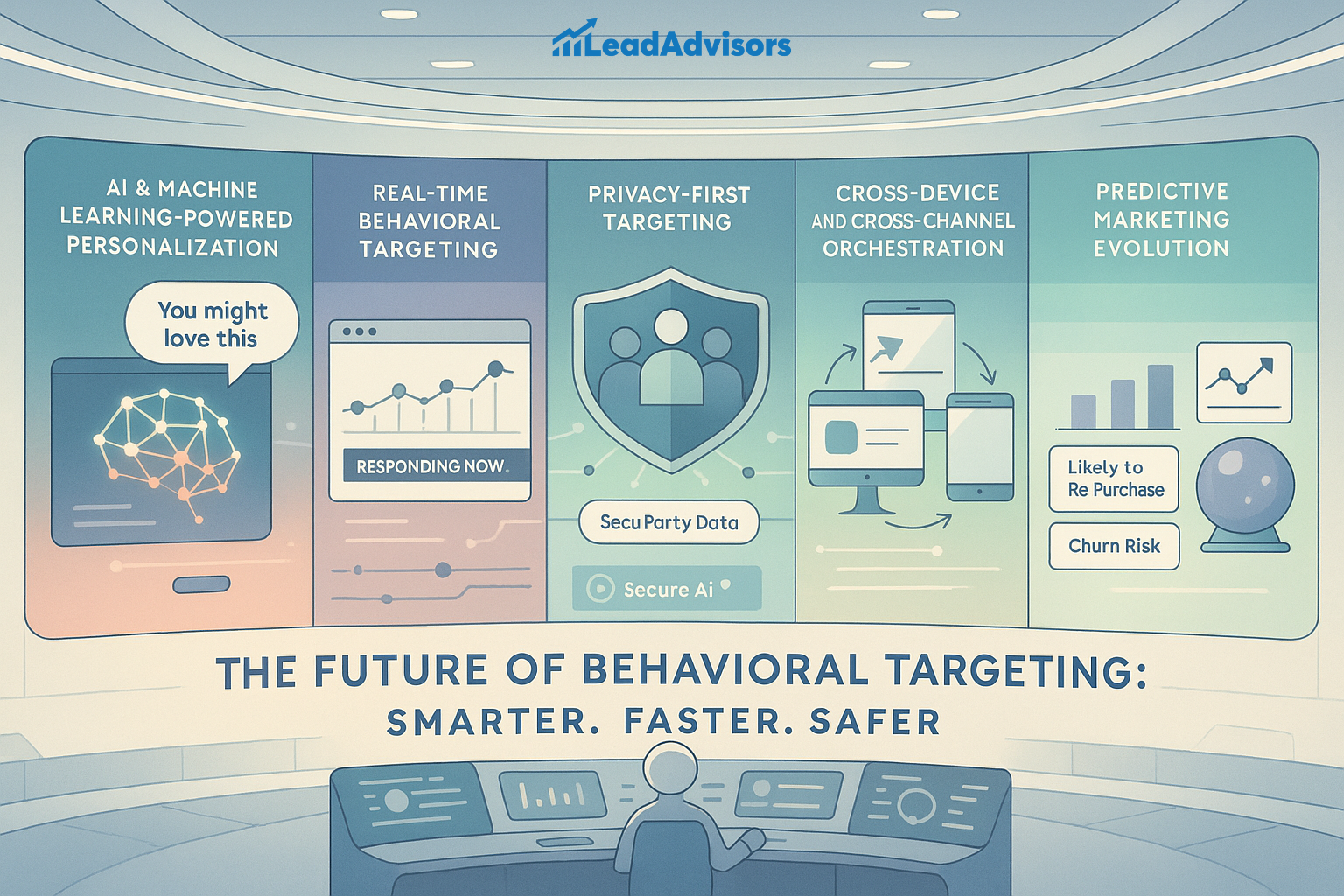
- AI & Machine Learning-Powered Personalization
Brands use machine learning algorithms to interpret behavior in real time and to trigger action whenever a personal message, offer, or communication can be sent about a customer, with no delay, no guesswork. - Real-Time Behavioral Targeting
No more waiting for reports. Now, marketers can act on an action as it occurs, to create personalized, meaningful content in the moment based on clicks, scrolls, and visits. - Privacy-First Targeting
As concerns over the use of data continue to increase, tools such as federated learning and zero-party data give brands a way to personalize without giving up contact data or user trust. - Cross-Device and Cross-Channel Orchestration
Whether a person begins on mobile and moves to desktop, or shifts between email and app, marketers can now provide a consistent, personal experience at every stop along the way. - Predictive Marketing Evolution
Are you wondering which customers are most likely to buy again and again? Now, A.I. can predict future actions, enabling you to tweak digital advertising strategies before users lift a finger.
Ethical Considerations in Behavioral Targeting
Just because behavior is trackable doesn’t mean it always is – or at least that it is, without care, a good thing to do. Here’s what responsible behavioral targeting looks like now:
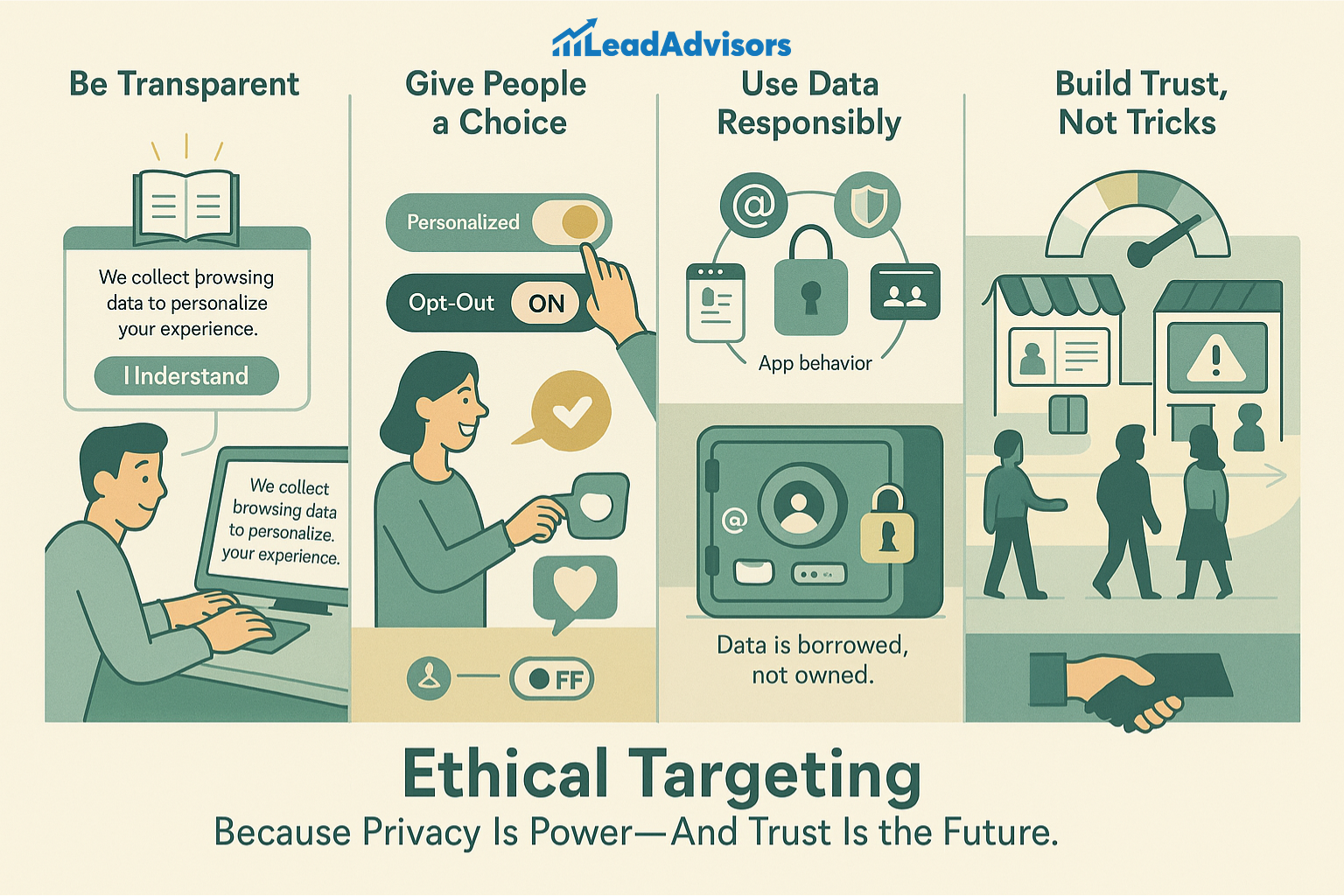
Be Transparent. Inform users what you are collecting and why. Whether you browse or consume personalized content, transparent communication definitely leads to trust. And there isn’t any secret to it – just some honesty.
Give People a Choice – Make it easy to opt out, and always take a user’s preference into account. Some people like custom experiences, and some don’t. The trick is letting them decide.
Use Data Responsibly – Design with behavior and contact data as if borrowed, not owned. Just grab as little as you can get away with and protect it like it’s gold, and only use it for the good of the user, and not to change them.”
Ethical targeting is not only the right thing to do – it is smart business. Because in a world of noise, trust is all you’ve got.
Your Behavioral Targeting Starter Playbook
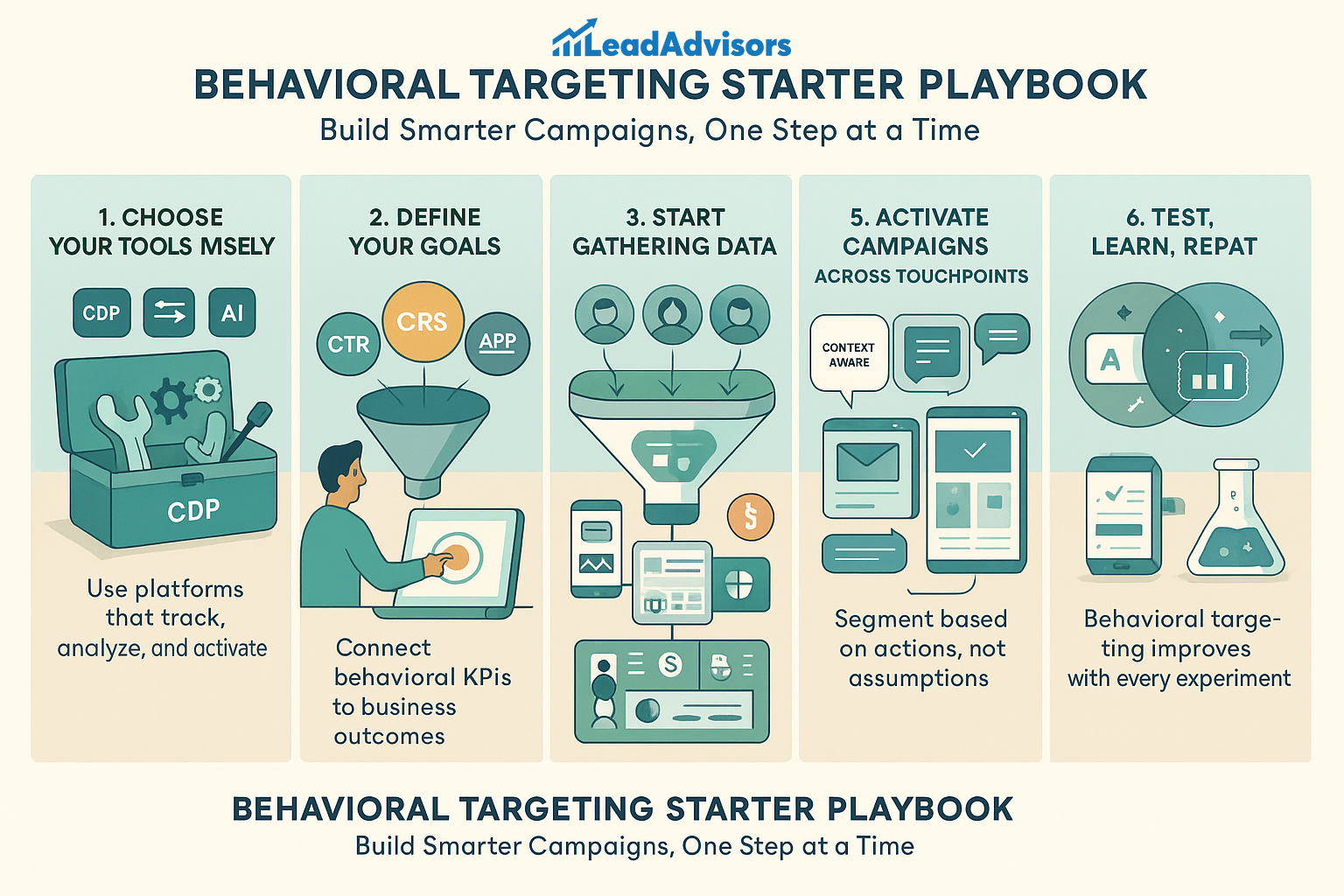
Step 1: Choose your tools wisely
You can’t run behavioral targeting without the proper engine. Considering one of the other 7,000 companies you’ve never heard of for your CDPs, analytics, and marketing automation that can actually track, measure, and activate behavior-driven campaigns.
Step 2: Define your goals
Precisely what are you trying to get better at? Click-through rates? Conversions? App usage? Choose behavioral KPIs that link to your business results to measure progression with intention.
Step 3: Start gathering data
Pull signals from all sources – site visits, mobile actions, email opens, and purchase history. The hope is to pool these behaviors into one central system so you can see the whole customer journey.
Step 4: Create strategic audience segments
Here is where it gets strong. Organize users around what they do, not just who they are. People who browse daily, versus those who abandon a cart, versus a returning customer – all of these groups should receive different, uniquely timed messages.
Step 5: Activate campaigns across touchpoints
Put your insights to work. Launch behavioral targeting campaigns in email, on your website, in SMS, and as paid ads. Be consistent in your messaging and be context-aware, regardless of where your audience encounters it.
Step 6: Test, learn, repeat
Watch how users respond. Play around with your segments, test out different offers, and A/B test your subject lines. Behavioral targeting is a living thing – it sharpens every time you use it.
Frequently Asked Questions
What is behavioral targeting and how does it differ from contextual targeting?
What kind of data is used in behavioral targeting?
Why is personalization so important in behavioral marketing?
What industries benefit most from behavioral targeting?
How can I get started with behavioral targeting without violating user privacy?
Why We Can’t Afford to Ignore Behavioral Targeting
If I’m being honest, when I finally grasped what Behavioral Targeting does, I totally reshaped how I look at my marketing initiative. It’s not just another buzzword – it’s a more human, more thoughtful way to engage people.
We are not living in a world where that one-size-fits-all messaging cuts it anymore. Our audience is looking for more, and they deserve it. What is the importance of Behavioral targeting? It allows us to talk to each person about what they’d actually shown an interest in, rather than what we thought they might like.
When we personalize responsibly – when we respond to actual activity, when we know how to respect limits and, sometimes, reply – and create work that feels right, we’re not only generating bottom-line results. We’re also building trust and demonstrating that we understand people.
So if you’ve been waiting, naive about where to begin, or simply burying your head in the sand and steering clear for fear of your lack of control, take it as your signal to get started with behavioural targeting. (No more guessing about how to proceed, simply create meaningful experiences.)
Because at the end of the day, we are not just marketers. We are humans communicating with humans. And that’s the sort of marketing that sticks.






